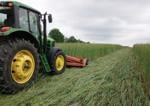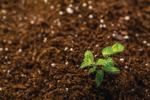Soil erosion is still a most serious issue in our country. With 60% of Pennsylvania cropland being highly erodible, it requires constant attention. The most important cause of topsoil loss is tillage erosion — hence the importance of no-till farming for sustainable agriculture.
Crop yields continue to improve, so what’s the big deal about soil erosion? Extension soil management specialist Sjoerd Duiker explains that is a common way of thinking.
However, buried in there is the fact that if you had not lost so much topsoil, your yields would be better still, and you would not have to use so much fertilizer.
A 2005 study compared corn yields of Iowa soils that had lost varying amounts of topsoil. The study found that corn yield was reduced approximately 16 bushels per acre if topsoil thickness was reduced from 15 to 0 inches on loess soils, and 26 bushels per acre on till-derived soils.
The latter would probably better reflect typical yield reductions on Pennsylvania soils.
Of course, topsoil loss is not uniform throughout a field — on hillcrests, no topsoil may be left, while in the bottom of the field topsoil depth may have increased due to deposition.
But yield losses would progressively increase if the areas without topsoil, or that have reduced topsoil depth, would grow.
It is therefore important to reduce this phenomenon. Research has shown that tillage erosion is the primary culprit of topsoil loss in undulating landscapes.
Tillage erosion goes hand in hand with water erosion, which is the washing away of the soil by water.
It happens with any type of tillage, although depth, speed and direction of travel also play a role. This is why the practice of no-tillage is so important to guarantee productivity of our soils into the future.
The Link LonkApril 29, 2021 at 05:05PM
https://ift.tt/3dZ86pY
Controlling Soil Erosion with No-Till | Latest News for Corn, Soybeans, Wheat and more | lancasterfarming.com - Lancaster Farming
https://ift.tt/3gguREe
Corn



No comments:
Post a Comment